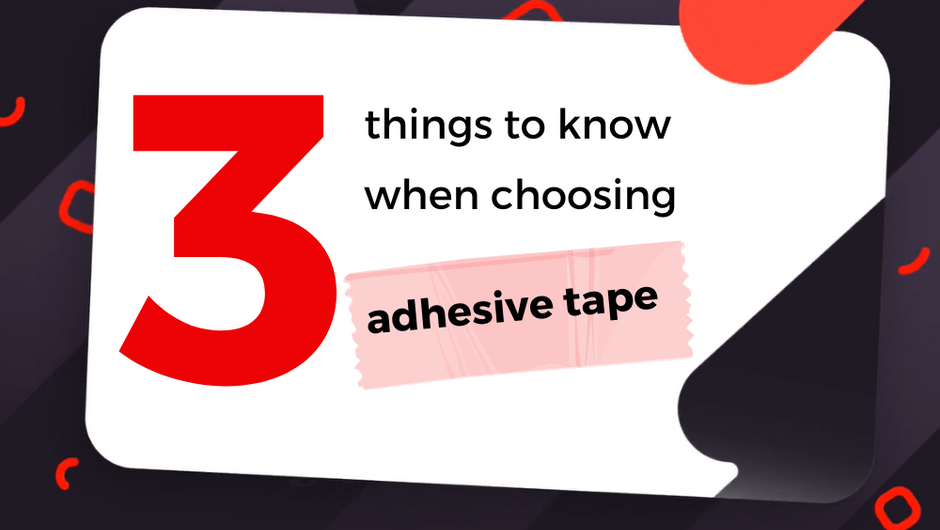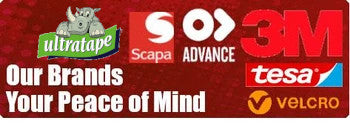You should never underestimate the power of adhesive tape. It’s versatile, durable and easy to use – and if you choose the right one, it can significantly speed up even the most time consuming tasks, providing you with a hard-wearing, long lasting solution.
However, with so many different tapes to choose from, it can be tricky to know which one is right for the job. To help decide which tape is best you for, we’ve drawn on our years of experience in industrial tapes and adhesives to pull together these useful hints and tips.
- Know the job
Firstly, you should establish what you need the tape for. The task you’re going to carry out will determine the type of tape you’re going to need, so it helps to have a clear idea of what you want to achieve.
Some examples of the job you may be carrying out could include:
Bonding
Joining two substrates together using a double sided tape. Sign makers are a good example but it can equally apply to a wide variety of Industries such as Automotive and Aerospace. Different substrates require different tapes in order to achieve a successful bond. Low surface energy plastics such as polyethylene and polypropylene require softer adhesives and may need to be primed.
Bundling / Box Sealing
Sealing boxes can be relatively straight forward. Carton weight is clearly a factor; stronger reinforced tapes such as filament tape maybe necessary. On some boards such as recycled board a solvent adhesive maybe required.
Bundling can be carried out with many different tapes. Normally a reinforced filament tape will be used depending on the weight and potential shock involved.
Masking / Splicing / Sealing / Protection
In all cases of using adhesive tape for masking, splicing, sealing and protection we need to identify the substrate, the temperature involved, the conditions and duration. On glass for instance, a general purpose tape in direct sunlight will bond solid in under 12 hours. In automotive applications they will always require either 80°C or 110°C tapes. Powder coated masking applications need tapes to withstand 200°C and must have a silicone adhesive and a polyester backing. Long term protection of window frames require removable adhesives with a life cycle of up to 12 months.
- Know your materials
It’s important that the tape you choose is suitable for the materials involved. So, to ensure the tape you choose does its job effectively, it’s worth taking this into consideration, regardless of whether you’re dealing with plastic, metal, wood or something else.
Metal
To guarantee optimum performance from your tape, you will need to think about what type of metal you need to bond and to what other substrate. Surfaces such as powder coated metal like brass may need priming or a tape with an adhesive designed for the job. Expert advice may have to be sought.
Plastics / Glass
Plastics can be split into high surface energy plastics such as acrylic and low surface energy plastics such as polypropylene. Each require different types of adhesive. HSE plastics are relatively easy to stick where as LSE plastics are notoriously difficult. Glass and glazing applications such as window bars may need the addition of a silane primer. Fortunately, advice is at hand via the Viking website and our technical support team.
Paper / Board
Paper and board are normally the easiest of materials to seal and bond for example in case sealing applications. However, there can be issues with reconstituted board and with some adhesives when applied at low temperatures. Therefore, a solvent rubber adhesive may be preferred to a hot melt or water based adhesive. In applications such as board / paper splicing, account needs to be taken of the temperature involved often up to 200°C when polyester tapes with a high temperature adhesive maybe necessary.
- Know your conditions
You should be aware of the conditions that can affect your tape’s performance too. Some of the factors you may want to take into consideration include:
Temperature
Generally speaking, the tackiness of a tape will depend on temperature, and the colder the climate is, the poorer the bond will be.
If you are working at lower temperatures, make sure you’re using a tape that has been specially designed to be used in colder conditions. Such as the 3M™ Venture™ range which can be applied at 0°C.
UV Exposure
Ultra Violet (UV) light can be extremely damaging to certain types of tapes, and too much exposure can mean it becomes hard and brittle – something you do not want in a tape that needs to hold for any duration, especially if it’s for outdoor use. Fortunately, you can minimise the effects of UV light by choosing a tape with inbuilt UV barrier protection. Using acrylic adhesives, as apposed to a rubber resin adhesive which will become brittle, is recommended.
Water and moisture
Especially if you’re using the tape outdoors, you need to pick one that is able to withstand water and moisture and temperature fluctuations.
Excellent examples are the 3M™ range of high bond acrylic foam tapes, used in widely in outdoor signage and also in outdoor construction projects such as curtain walling.
Choosing your tape
At Viking, we offer an impressive range of adhesive tapes which are suitable for a variety of different uses, including 3M™ products which are recognised worldwide for their reliability. This includes masking tapes used in industries like aerospace and marine, double coated tapes which can be used in conjunction with an ATG handgun for accurate placing and liner removal, indoor foam tapes used in signage, venture tapes which can be used at very low temperatures, and VHB™ tapes renowned for their reliability and strength both indoors and outdoors for use on LSE plastics without the use of primers. We also offer customisation of things like printed packaging tapes with your logo and can cut tapes to different shapes and sizes for specific applications.
Browse the full range of vikingtapes.co.uk and contact our technical team if you need support. You can also download this guide as a pdf here.



